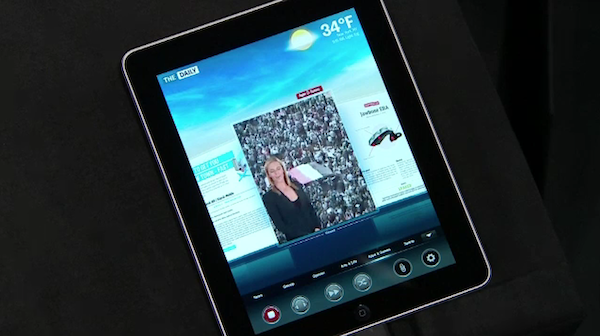What 'The Daily' means to you

At Noon ET today, News Corp. launched its original iPad newspaper The Daily. During an event that started an hour earlier, News Corp. president Rupert Murdoch said the target audience is the 50 million American users expected to have purchased iPads by end of this year.
The Daily means nothing to you if you don't live in the United States, don't own an iPad or don't plan to buy Apple's tablet. For US iPad users, The Daily builds on some other innovative publications already available for iPad, such as Virgin's Project or Wired. From a user experience perspective, what really differentiates The Daily, immediately anyway, is the subscription model -- "14 cents a day," Murdoch says. Right now, iPad publications like The New Yorker and Wired are only available on one-off bases, and they cost lots more.
Price is everything in news, something a media mogul like Murdoch knows all too well. Every newspaper's biggest competitor is free content, of which there is plenty on the Web -- and then some. The Daily readers will be billed 99 cents per week or $39.99 per year. So for the price of one song from iTunes store, iPad users can get a week's The Daily, with its mix of text, 360-degree photos and HD videos.
During today's event, Apple promised an announcement in the near future about subscriptions being available for other publications. In that regard, The Daily will mean something to people who want iPad versions of publications for which they must pay near-newsstand prices today. But competitors will have to rethink pricing.
Premium or Mass-market Pricing?
I sold my iPad in December, but might have kept it had lower subscription prices been available for The New Yorker and other publications. Condé Nast charges $4.99 for each weekly The New Yorker on iPad, much more than the $39.99 for 47 issues in print. Wired.com, which also is owned by Condé Nast, put some perspective on the digital pricing in a Sept. 27, 2010 post. John Abell writes: "Media executives inside and outside of Condé Nast have told wired.com that they are determined to try to charge more for digital subscriptions than they do for print -- small digital dollars instead of print pennies -- because they believe they are offering a much greater experience and value than possible on paper."
This is exactly the opposite of Murdoch's strategy. During today's launch event he explained how The Daily was designed from the ground up for digital distribution. "New times demand new journalism," he said. In the "tablet era there's room for a fresh and robust voice." That voice is cheaper to produce, despite $30 million start-up costs, savings The Daily will pass onto subscribers, Murdoch emphasized.
The pricing feels right, like 99 cents did for songs and $9.99 for albums, when iTunes Music Store launched in April 2003 -- or that $139 price Amazon introduced for Kindle last year. The Daily promises to offer more immersive news for less money. Is 99 cents really that much different from free? That's the question other publishers will now have to ask. The days of publishers like Condé Nast treating iPad as a premium product are already over. Murdoch is thinking mass market and tens of millions of paying subscribers. "The Daily's success will be determined by its utility and originality," Murdoch said today. Part of that utility is the low subscription pricing.
Immersion Experience
Contrary to previous assertions, The Daily won't be exclusive to iPad, Murdoch said that the digital newspaper would be available elsewhere. "We will expect to be on all major tablets," he said. However, "this year and next year belong to Apple."
What does all this mean for The Daily readers? In January 2010, I posted: "The world doesn't need an Apple tablet, or any other." That was when there were iPad rumors but no official announcement. Six months later came my mea culpa: "I was wrong about Apple iPad." I decided the world needed an iPad, and tablets like it, after all. Apple hadn't announced sales figures yet, and then seemingly early popularity bore little on my turnabout. I changed my position because of my shocking user experience with iPad. I used "immersive" 18 times in that post, describing how reading on iPad was different from books or PC Web browsing: "There is something immersive about consuming content on iPad that does change the Web experience -- and that of other media." During today's The Daily launch event, Murdoch and others repeatedly used "immersive" to describe the user experience.
Human beings are tool users who experience and manipulate the world through five senses. The eyes are passive instruments, while the hands and fingers are more important because they are active -- they're how people tactilely manipulate the world around them. For example, how important is touch? Watching how people interact with items for sale reveals much. First people look -- and then they touch. Surely, many retailers find all that touching and handling of their goods to be irritating. People examine objects they desire as much with their hands as their eyes.
The Daily, and some other publications already available for iPad, utilize sight, sound and touch. Part of the immersive experience is the use of these senses to interact with content. Every publisher's dream is immersion. It means that people spend more time consuming their content than others'. That's good from a subscriber retention perspective and for securing advertising. What? You think 99 cents a week will support The Daily? News Corp. needs advertisers for the tablet newspaper to succeed. They'll be looking at reader demographics and how much time subscribers stay in the iPad app. Immersion will be hugely important.
I won't predict whether or not The Daily will succeed. But I don't see it failing for want of lower subscription pricing or for a more immersive user experience.